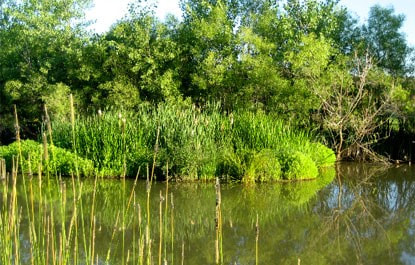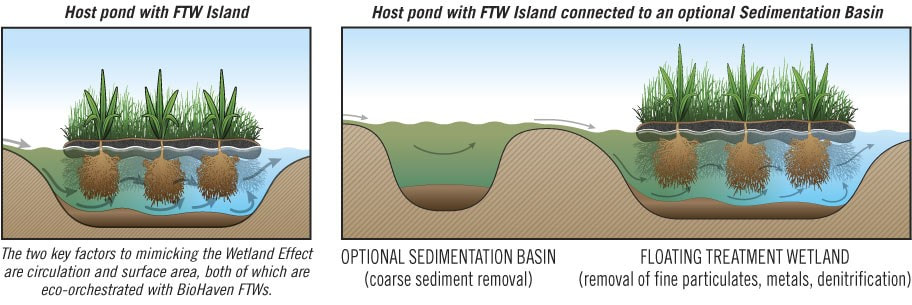The first FLOATING ISLAND
at Wizard Lake
was unveiled on September 9 at Jubilee Park
following the Shoreline Cleanup
at Wizard Lake
was unveiled on September 9 at Jubilee Park
following the Shoreline Cleanup

BioHaven® Technology
BioHaven® floating islands (also known as floating treatment wetlands or FTWs) are a new and powerful tool in water stewardship. They biomimic natural floating islands to create a “concentrated” wetland effect. Independent laboratory tests showed removal rates far in excess of previously published data: 20 times more nitrate, 10 times more phosphate and 11 times more ammonia, using unplanted islands. They are also extremely effective at reducing total suspended solids and dissolved organic carbon in waterways.
The unique design of BioHaven floating islands means that 250 square feet of island translates to an acre’s worth of wetland surface area. These versatile floating islands can be launched in either shallow or deep water, and can be securely anchored or tethered to ensure that they remain in a specific location. They are almost infinitely customizable, and can be configured in a variety of ways.
How They Work
Constructed of durable, non-toxic post-consumer plastics and vegetated with native plants, BioHaven islands float on top of the water, providing a beautiful habitat for birds and animals. But underneath the surface, a dynamic process takes place.
Microbes are responsible for breaking down nutrients and other water-borne pollutants, but to be effective, they need a surface to stick to. The floating island matrix, with its dense fibers and porous texture, is the perfect surface area for growing large amounts of microbes (in the form of biofilm) in a short time. Nutrients circulating in the water come into contact with these biofilms and are consumed by them, while a smaller fraction is taken up by plant roots. Suspended solids slough off into the benthic zone below the island. Organic solids stick to the biofilms and become the base of the freshwater food web.
These pathways represent a concentrated wetland effect-nature’s way to clean water.
The Result
Because Biohaven floating islands are able to withstand fluctuations in water levels, without becoming stranded or inundated, they are very suitable for the treatment of runoff and drainage , such as urban stormwater, agricultural runoff and other non point-source applications. They can be launched over deep or shallow water, including streams and detention basins, and they represent an inexpensive option to retro-fit to existing systems, such as wastewater lagoons. The sticky biofilm which covers the roots and matrix acts as a mechanical filter for fine particulates, while the island itself provides shade to cool the water, and blocks the light that might otherwise encourage sub-aquatic weeds. Overhanging banks act as wave-breakers and allow passage of fish underneath. In a lake or reservoir setting, the conversion of nutrients to periphyton initiates the food chain and contributes to insect and fish growth, which are the hallmark of a healthy and productive ecosystem.
©2017 Floating Island International, Inc. All rights reserved.
BioHaven® floating islands (also known as floating treatment wetlands or FTWs) are a new and powerful tool in water stewardship. They biomimic natural floating islands to create a “concentrated” wetland effect. Independent laboratory tests showed removal rates far in excess of previously published data: 20 times more nitrate, 10 times more phosphate and 11 times more ammonia, using unplanted islands. They are also extremely effective at reducing total suspended solids and dissolved organic carbon in waterways.
The unique design of BioHaven floating islands means that 250 square feet of island translates to an acre’s worth of wetland surface area. These versatile floating islands can be launched in either shallow or deep water, and can be securely anchored or tethered to ensure that they remain in a specific location. They are almost infinitely customizable, and can be configured in a variety of ways.
How They Work
Constructed of durable, non-toxic post-consumer plastics and vegetated with native plants, BioHaven islands float on top of the water, providing a beautiful habitat for birds and animals. But underneath the surface, a dynamic process takes place.
Microbes are responsible for breaking down nutrients and other water-borne pollutants, but to be effective, they need a surface to stick to. The floating island matrix, with its dense fibers and porous texture, is the perfect surface area for growing large amounts of microbes (in the form of biofilm) in a short time. Nutrients circulating in the water come into contact with these biofilms and are consumed by them, while a smaller fraction is taken up by plant roots. Suspended solids slough off into the benthic zone below the island. Organic solids stick to the biofilms and become the base of the freshwater food web.
These pathways represent a concentrated wetland effect-nature’s way to clean water.
The Result
Because Biohaven floating islands are able to withstand fluctuations in water levels, without becoming stranded or inundated, they are very suitable for the treatment of runoff and drainage , such as urban stormwater, agricultural runoff and other non point-source applications. They can be launched over deep or shallow water, including streams and detention basins, and they represent an inexpensive option to retro-fit to existing systems, such as wastewater lagoons. The sticky biofilm which covers the roots and matrix acts as a mechanical filter for fine particulates, while the island itself provides shade to cool the water, and blocks the light that might otherwise encourage sub-aquatic weeds. Overhanging banks act as wave-breakers and allow passage of fish underneath. In a lake or reservoir setting, the conversion of nutrients to periphyton initiates the food chain and contributes to insect and fish growth, which are the hallmark of a healthy and productive ecosystem.
©2017 Floating Island International, Inc. All rights reserved.
Financial Assistance for this website was provided by the
Land Stewardship Centre
Land Stewardship Centre



